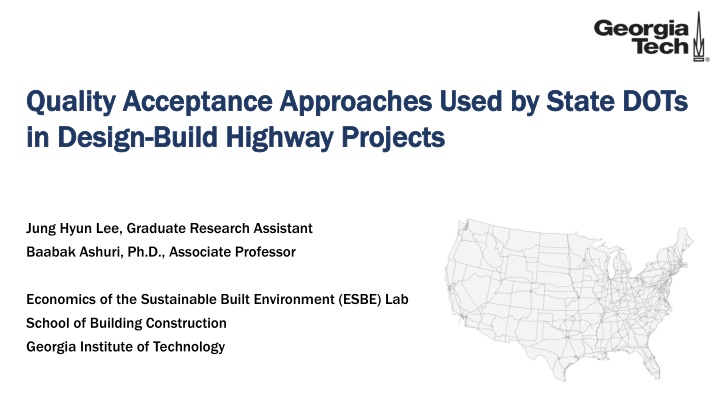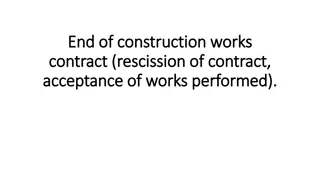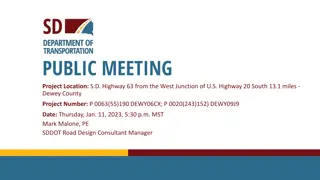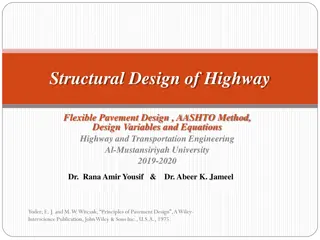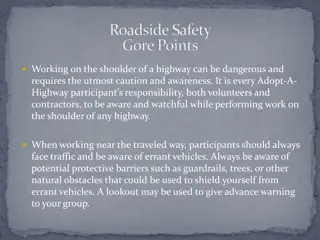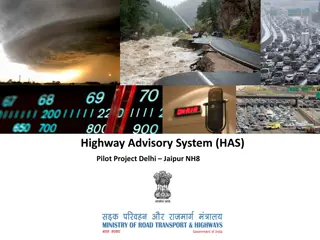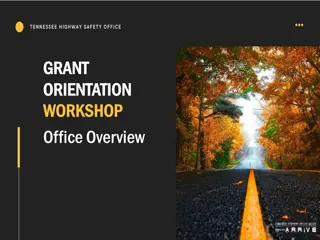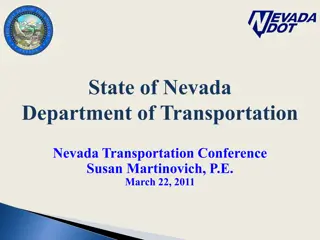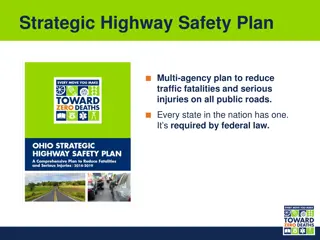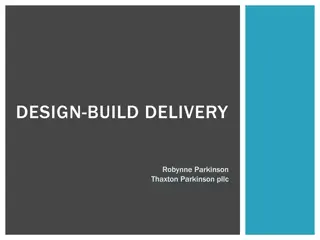Quality Acceptance Approaches in Design-Build Highway Projects
Challenges and objectives faced by State DOTs in implementing quality acceptance approaches for design-build highway projects. Research methodology, changes in quality management, and decision-making factors influencing QA practices are explored.
Download Presentation

Please find below an Image/Link to download the presentation.
The content on the website is provided AS IS for your information and personal use only. It may not be sold, licensed, or shared on other websites without obtaining consent from the author.If you encounter any issues during the download, it is possible that the publisher has removed the file from their server.
You are allowed to download the files provided on this website for personal or commercial use, subject to the condition that they are used lawfully. All files are the property of their respective owners.
The content on the website is provided AS IS for your information and personal use only. It may not be sold, licensed, or shared on other websites without obtaining consent from the author.
E N D
Presentation Transcript
Quality Acceptance Approaches Used by State DOTs Quality Acceptance Approaches Used by State DOTs in Design in Design- -Build Highway Projects Build Highway Projects Jung Hyun Lee, Graduate Research Assistant Baabak Ashuri, Ph.D., Associate Professor Economics of the Sustainable Built Environment (ESBE) Lab School of Building Construction Georgia Institute of Technology
Contents Research objectives Research methodology Changes in quality management Six cores of quality assurance program Three approaches to acceptance Overall interview results Interview results Detailed answers from state DOTs Decision-making factors Conclusions
Research objectives Challenges of state departments of transportation (DOTs) Ambiguity of roles and responsibilities for quality-related activities in procurement packages The loss of agency s direct control over day-to-day quality activities Decreasing experienced internal staff of DOTs To identify the current challenges associated in QA for DB highway projects To present critical drivers of decision making To provide a synthesis of the current QA practice of state DOTs
Research methodology A two-step process 1 2 Structured interviews - Identify important challenges - Present critical drivers Content analysis of quality management guidelines from FHWA and DOTs Questionnaire interviews Follow-up questions
Changes in quality management Quality Assurance QA / QC Quality Control (Contractor s responsibility) Acceptance (Agency s responsibility) Quality Assurance (QA) refers to the overall system for assuring project quality as an umbrella term
Changes in quality management (contd) Revised 23 CFR 637 (Title 23, Code of Federal Regulations, Part 637) states that FHWA allows for state highway agencies to use QC testing results of contractor in acceptance decisions if QC testing results are verified by agencies or its designated representatives 1995 2004 2012 FHWA published the Technical Advisory to provide guidance and recommendations for the use and validation of contractor s test results for acceptance FHWA published the TechBrief to clarify the roles, responsibilities, and activities related to construction QA on design-build projects .
Six cores of quality assurance program Prime importance QC: Generally recommended as the design-builder s responsibility Acceptance: Mainly the agency s responsibility IA (Independent assurance): Usually responsibility of the agency s material department Dispute Resolution IA Personnel Qualification Acceptance Support for QA program Dispute resolution: Dealing with prevention and management of any disagreements or discrepancies arising in the QA process Personnel qualifications: The minimum qualifications associated with various job roles in a QA program Laboratory accreditation: Requiring all the material testing be done in accredited laboratories QC Laboratory Accreditation
Three approaches to acceptance Levels of Owner involvement in acceptance HIGH LOW Supervisory Approach Traditional Approach Mixed Approach Similar to acceptance approach in design-bid-build projects The design-builder is responsible for quality control The state DOT is responsible for all acceptance tasks The state DOT, or its consultant, conducts all the verification sampling and testing
Three approaches to acceptance (contd) Levels of Owner involvement in acceptance HIGH LOW Supervisory Approach Traditional Approach Mixed Approach (1/2) The owner assumes active role in carrying out the acceptance duties on a daily basis and may hire an owner s verification firm to act on its behalf The design-builder s QC data, or design-builder s quality assurance firm (CQAF), testing data is taken into consideration in the acceptance process The state DOT may choose to include design-builder s QC data, or CQAF s test data towards its acceptance decision
Three approaches to acceptance (contd) Construction Quality Assurance Program (CQAP) DOT Levels of Owner involvement in acceptance Independent Assurance (IA) DOT Quality Control Program Developer HIGH LOW Acceptance Program Supervisory Approach Traditional Approach Mixed Approach Quality Acceptance CQAF Owner Verification OVF (2/2) The design-builder performed acceptance is the first line of acceptance by a firm hired by the design-builder with the consent of the owner The owner performed acceptance is done by the state DOT itself or representative directly hired by the state DOT Typically, the owner performs random sampling and testing at a 10% rate of the frequency of the sampling and testing done by design-builder
Three approaches to acceptance (contd) Levels of Owner involvement in acceptance HIGH LOW Supervisory Approach Traditional Approach Mixed Approach The owner is not actively involved in day-to-day acceptance activities The owner only retain minimal involvement The design-builder is primarily responsible for day-to-day acceptance activities
Overview of E-mail Survey results WA ME MT ND MN VT OR WI ID NY MA MI WY PA CT NJ NE NV OH IN IL UT WV DE MD CO CA VA KS MO NC TN AZ AR SC NM GA AL MS LA TX FL Sent email and responded 17 Sent email but not responded yet 21 Not sent email 13 Overview of E-mail Survey
Interview results Traditional Approach MD, MN, MT, SC 4 Mixed Approach 9 CO, FL, GA, ME, MI, MO, OR, TX, WS Mixed & Traditional Approach 2 MA, UT Supervisory Approach 1 VA All Approaches 1 OH
Interview results (contd) Consistent Florida, Georgia, Oregon, Maine, Michigan, Montana, South Carolina, Texas, Virginia, and Washington 10 7 Flexible Colorado, Maryland, Minnesota, Massachusetts, Missouri, Ohio, and Utah Consistent Flexible
Detailed answers from state DOTs Ohio Traditional approach For majority of ODOT s DB projects which are procured via low-bid, the traditional approach towards acceptance is implemented where acceptance and verification is done in-house. Mixed approach On their first two major DB projects with project costs in excess of $200 million, a mixed approach towards acceptance was adopted. Supervisory approach On a current DBFOM project which requires the developer to maintain the project for 35 years, the department has adopted the supervisory approach. They felt that since their risk was lowered because of the long-term contract, spending heavily on quality assurance did not make sense.
Detailed answers from state DOTs (contd) Maryland Traditional approach The typical approach for acceptance in DB projects in Maryland is the traditional approach. Mixed approach However, on the $2.4 billion Intercounty Connector project, the department did not have enough resources to provide quality management through their typical approach. Hence the decision was made to include developer in the acceptance process. Missouri Traditional approach On smaller projects, MoDOT has experimented with conducting acceptance in-house. Mixed approach For most projects, MoDOT follows the mixed approach towards acceptance. On larger projects, the contractor is expected to perform both quality control and acceptance while MoDOT only retains the responsibility of quality verification.
Detailed answers from state DOTs (contd) Massachusetts Their determination towards acceptance approaches is made based on the project specific risk areas and the design-builder s performance and credibility. They will perform more detailed reviews and inspections on issues with potential to affect public safety, or on non-standard designs & operations like a post-tensioning. If the design-builder s quality control is lacking, the department increases its level of review and inspection. Utah They also decides whether to use an IQF or perform QA in-house based on factors like project size and availability of in-house resources.
Decision-making factors Involvement of O&M component The current availability in- house QA personnel Capability and experience of the design-builder Choosing Acceptance Approaches Past experience of agency with similar projects The size of project Motivation to save on project cost and schedule Six critical drivers were defined
Conclusions The roles and responsibilities associated with acceptance show spectrum of variation. 10 out of DOTs do not change their approach; however, the other seven DOTs tend to change their acceptance approaches Critical drivers that make DOTs choosing different acceptance approaches are similar across all DOTs To increase validation of decision-making factors, assessment of these factors are required for the future plan
